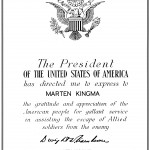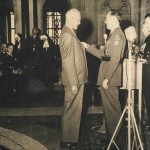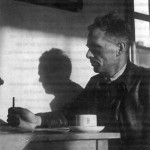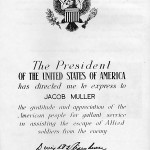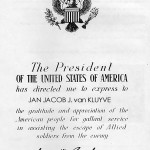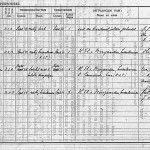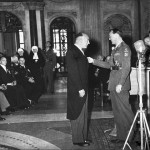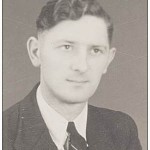Back to ‘Luchtoorlog’ Back to ‘Lezen’
Original in Dutch;
Author: Aaldert Pol
At first the instructions to downed airmen was that they should turn themselves in when they landed at enemy territory. But early 1943 a change was made, and they were assigned to get back to England. They even were given some day off and a bonus, when they managed to reach England.
The resistance played a part in it as well, and tried to do all the possible to help those airmen via escape routes to a neutral country. So the amount of airmen that, did not fall into the hand of the German occupier, was estimated to be about 245.
(Source: Ypma, Y.N., “Friesland Annis Domini 1940-1945”, 1965. p.247).
Introduction
The help to airmen in the North East Polder was slightly less risky than outside of the area. At the routes out of the Polder sometimes guards were placed, and it could became dangerous, but setting up a escape line it self was most dangerous. Itself would require an organisation. In the polder the conditions fort he resistance were not optimal.
People did not know each other, and by that were not able to see if someone would be worth trusting.
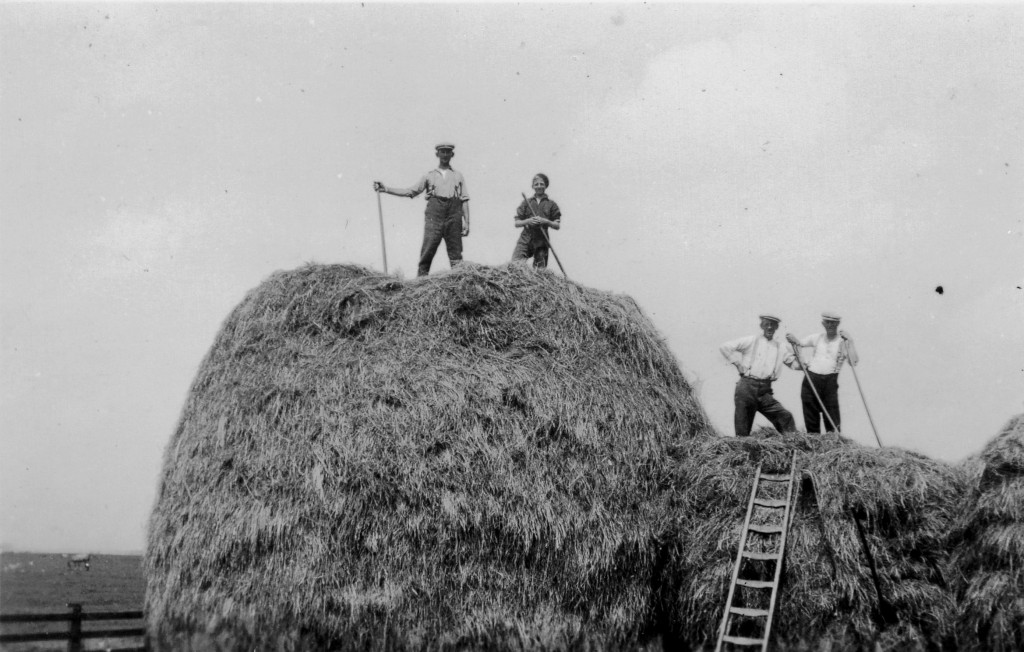
Resistance group Visser
The resistance group from Harmen Visser had some meetings in camp Kadoelen. The camp manager A. Overink was involved in the resistance work, but noted sober about this work; “We distributed some reading and sometimes gave help to pilots.” He’d get in touch with the resistance work joined the resistance by contact with pastor J. Wolven from Vollenhove.
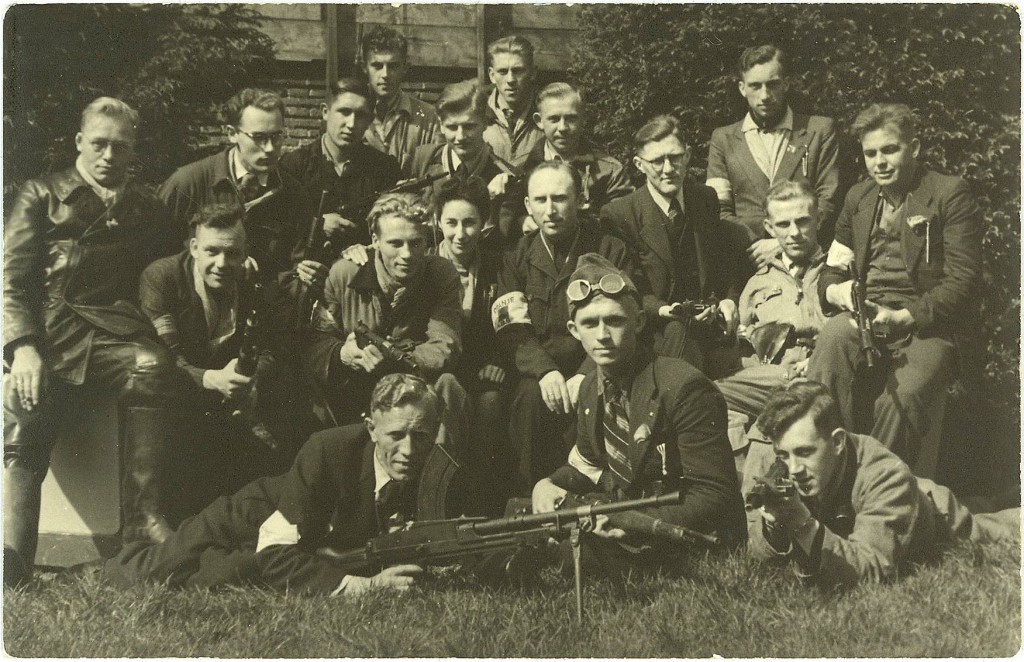
Kingma
The building company of Kingma’s played a key role in the help offered to downed airmen. That company was involved in the construction of farmhouses and town houses in the polder. The headquarters of the company was in Leeuwarden with a carpentry business, led by Harm Kingma. That was because all the lines came together of the Frisian resistance group, led by leaders P. Oberman and Kr. van der Helm.
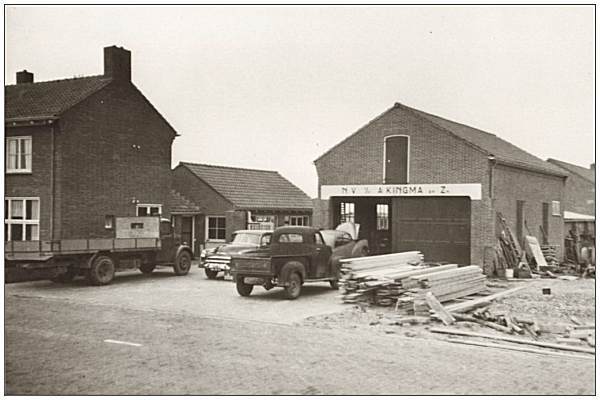
The brother of Harm, Marten Kingma (1893-1965) settled in 1942 in Vollenhove. He was the general manager of the company Kingma. Besides the company Jaap Muller, the chief executor was living was housed. He was the man of the earlier mentioned quest through the cane fields [See article: De B-17 van piloot Bob Harrah]. . Furthermore, as a driver were employed Meindert Heidema and Klaas Bijlsma. Son Frank also transported, initially without a license, many pilots. The company had three cars and two trucks, painted in gray of the Wehrmacht. Often a sign NOPolder was put up in front of the cars. That sign did sometimes wonders. The company had the right to cross the polder roads.
In the polder itself Damstra K. and P. Sandra, both executors were living. The company’s staff came daily together in the polder. They also knew who from all the camp administrators were reliable. In this way the help to downed airmen could be organized. Most often the airmen were sheltered in Vollenhove at the house of Marten Kingma, or his brother in law Jacob Muller, notary Van Kluyve or E. van der Linde in the Moespot. From Vollenhove they were further helped to Meppel under the guise of hitchhikers.
Bijlsma
Driver Klaas Bijlsma about the way his boss arrange this help:
After the war it showed how
“Klaas, you have to get some load to Meppel. Drive along the Oldenhof, there are a few people besides the road, whome you have to take with you.” You knew that they were pilots. Then I drove those people usually through Zwartsluis-Beukersluis to Meppel. The lock was the most dangerous point, because if there was a control, there was no other way to go. The last part of the route was about Zomerdijk along the Meppelerdiep. Arriving at the place where the water was the closest to the road, I stopped and let the airmen go. Back then then there was a deep still a towpath. I taught the people the direction they had to walk. Conversation was not conducted, because I did not understand English. ”
(Source: Pol, A., “Chauffeur in oorlogstijd”, ‘de polderkrant’, 23 maart 1992)
After the war it showed how important the shift in Meppel was for both pilots from Friesland and from the polder.
The Kingma’s have a list of 37 airmen helped by them. Missing five because the total number is 42. Of these 42, most came from the polder. In the family album of mrs. R. van Dijk-Kingma there were also some pictures of the airmen helped. The photographs had been necessary to get these airmen a forged identity.
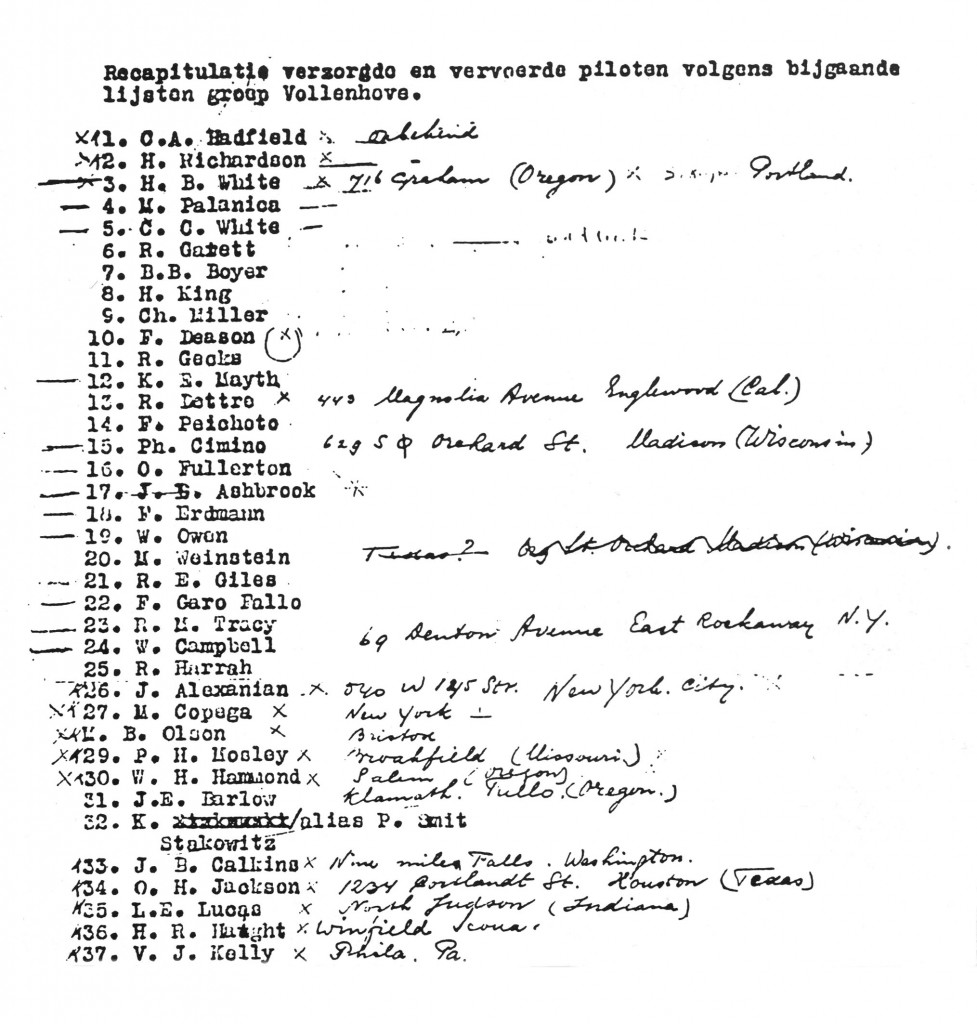
Soetendal
On one occasion Wiebe Soetendal taken a airmen behind his motor take to Kampen. Arriving there, one could’nt help him further, the airmen was then brought to Vollenhove to notary Van Kluyve. It was known by Soetendal that pilots could be helped through Vollenhove. But, the pilot still came back to Kampen because the escape line-Vollenhove was not functioning at that time. Soetendal didn’t know what the outcome was.
Knipmeijer reported in September 1945 that the airmen, found in the southern part of the polder, were put at an escape line by J.L. Snoep.
(Source: Knipmeijer, A.J., “Holland’s hiding ‘Paradise” Dossier Ministry of Social Affairs September 1945. Copy archive municipality Noordoostpolder.).
Wiebe Soetendal did not know this line did existed.
It is likely that the number of pilots who escaped via Kampen was low. The escape was only through Vollenhove. Finally, a note that there some pilots escaped through Urk from the polder. It involves a number below ten.
The total amount of airmen escaped out of the North East Polder is probably above the 50.
Marten Kingma, director
Marten Kingma’s son Frank (1925) is still alive and told a few things about that time. His father was for anyone a man of authority, he was the central figure and was always present. Non-family members (Evert van der Linde (1919-2006), Klaas Bijlsma (1920-2013) endorse that. He was a natural leader and gave orders in a way which was impossible to refuse it. It went like this:.. “Frank, if you deliver, this afternoon, three packets to Meppel! “Then Frank knew that his father had a call with Peter van der Hurk from Meppel. He did this without contradiction. Kingma sr. was a man of few words, but spoken with such authority that you simply did what was asked of you. You took it for granted that it was safe. You did’t think about it.
Frank can tell a lot from it. In Vollenhove they received a visit from the German Commander, because of insufficient embezzlement. The officer entered with a lot of noise with behind two soldiers with rifles on their shoulders. Frank about this: “My father could not speak German. I had to translate and then I began: “mein Vater sagt … that it is not appropriate to enter a property in this way. Whether he wanted to send out soldiers but, otherwise he would notify the Commander in Zwolle of the matter. “And truly, they went outside. Then the conversation about the embezzlement and the end of the song was that my father refused to tighten everything fort he embezzlement. And it was still accepted.
Another example was the arrest of their car somewhere in the Netherlands. They had to show the Ausweis. They barked … Name! My father refused and pointed to the Ausweis, on which the name was already mentioned.
Incidentally, people were sometimes appallingly naive and reckless. Frank remembers how a machine gun with the bullet belts coming from a crashed plane were lying in the garage. The machine gun was intended for a resistance leader Oberman in Friesland.
Marten Kingma
Marten Kingma was an atheist, but was friendly towards other different faiths. As the Reformed pastor Tjadens often visited him. A very nice guy, according to Frank, who was in the resistance. He got the nickname of “The flying gospel.” pastor Tjadens died during the war to diphtheria.
The religious background did not matter. The only thing for Kingma which was important was ‘if the man was trustworthy’. If you once have ashamed his confidence, it was done with having contact. He was fiercely anti-Nazi and had after the war he hated to travel through Germany. He did not want to take a break, at least not for eating.
Harm Kingma
Harm Kingma in Leeuwarden was a Mennonite and had principal objections to the use of violence. His brother Marten was political social democrat and that meant, before the war, the dislike of weapons. Yet both brothers would, when the need came, not fear back to use weapons against the occupier. In July 1944, after the arrest of the two drivers Meindert Heidema and Klaas Bijlsma, the whole family had to go into hiding. They went to Eernewoude where th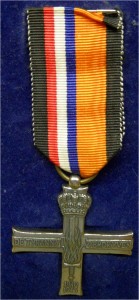 e grandparents lived. In De Oude Vennen, a water, was a houseboat where the family was staying.
e grandparents lived. In De Oude Vennen, a water, was a houseboat where the family was staying.
“For father it was a very difficult time when his driver Klaas Bylsma was locked up in prison in Leeuwarden. He perked up when completely when was got out again.”
After the war the family was heavily penalized by the many months of hiding. The time of the working had started again. About the war wasn’t talked anymore. Roll up the sleeves and work again.
The children did sang: big scoops, low wages [grote schoppen, lage lonen]. He himself set the example and had enough of four hours of sleep.
In 1955 he had a serious car accident. On 9 December 1965 Marten Kingma died in hospital in Arnhem. The cremation took place, five days later in Groningen.
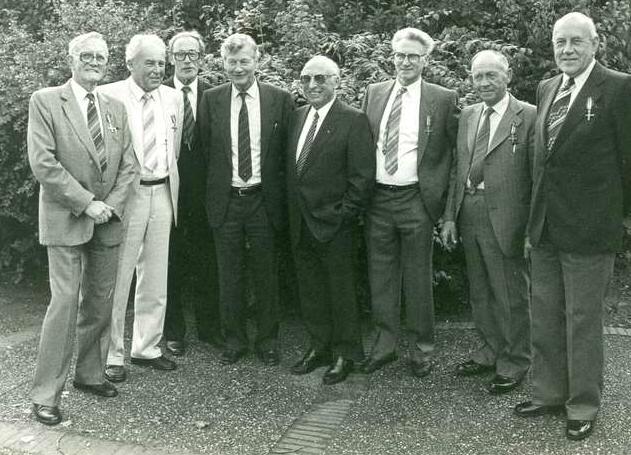
Carriers of the ‘Verzetskruis’ from l to r.: Hein Rozema, Jan van Loon, Ab Overink Minister Jan de Koning, Bob Arons, Roel Buimer, Arend Rodermond and Martin Lock.
Uitreiking Verzetskruis
In December 1983 the awarding took place in Vollenhove of, not less then five medals to members of the Group Vollenhove of the de binnenlandse strijdkrachten (BS) in World War II. They all got the Verzetskruis’. From left to right on the picture: Hein Rosema, Jan van Loon, Ab Overink Minister Jan de Koning, Bob Arons, Roel Buimer, Arend Rodermond and Martin Lock. Ab Overink and Bob Arons had the Resistance Cross already received earlier.
Minister Jan de Koning, born in Zwartsluis, did hand over the medals.
Sources
Book: “De bevrijding van het Nederlands Onderduikers Paradijs”, door Aaldert Pol. Uitgave Museum Schokland, 1995, Schoklandreeks nr 4.
http://emmeloord.info
http://www.flevolandsgeheugen.nl
http://www.henkvanheerde.nl
http://www.teunispats.nl
https://nl.wikipedia.org
